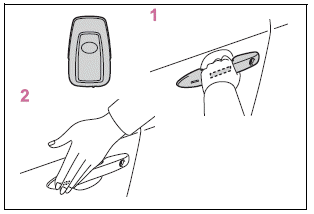Toyota Corolla: Engine (ignition) switch (vehicles with a smart key system) / When stopping the engine with the shift lever in a position other than P (vehicles with a continuously variable transmission)
If the engine is stopped with the shift lever in a position other than P, the engine switch will not be turned off but instead be turned to ACC. Perform the following procedure to turn the switch off:
1 Check that the parking brake is set.
2 Shift the shift lever to P.
3 Check that “ACCESSORY” is displayed on the multi-information display and press the engine switch shortly and firmly.
4 Check that “ACCESSORY” or “IGNITION ON” on the multi-information display are off.
NOTICE
■To prevent battery discharge
Do not stop the engine when the shift lever is in a position other than P. If the engine is stopped in another shift lever position, the engine switch will not be turned off but instead be turned to ACC mode. If the vehicle is left in ACC, battery discharge may occur.
 Changing engine switch modes
Changing engine switch modes
Modes can be changed by pressing the engine switch with brake pedal (continuously
variable transmission) or clutch pedal (manual transmission) released...
 Continuously variable transmission (vehicles without paddle shift switches)
Continuously variable transmission (vehicles without paddle shift switches)
Select the shift position depending on your purpose and situation.
Shift position purpose and functions
■When driving with the dynamic radar cruise control or dynamic radar cruise
control with full-speed range activated
Even when switching the driving mode to sport mode with the intent of enabling
engine braking, engine braking will not occur because dynamic radar cruise control
or dynamic r..
Other information:
Toyota Corolla 2019-2025 Owners Manual: Child restraint system fixed with a child restraint LATCH anchor
■ Child restraint LATCH anchors LATCH anchors are provided for the outboard rear seat. (Marks displaying the location of the anchors are attached to the seats.) ■ When installing in the rear outboard seats Install the child restraint system in accordance to the operation manual enclosed with the child restraint system. 1. If the head restraint interferes with your child restraint system, an..
Toyota Corolla 2019-2025 Owners Manual: Keys
The keys The following keys are provided with the vehicle. ► Type A A - Keys (without a wireless remote control function) B - Key number plate ► Type B A - Keys (with a wireless remote control function) Operating the wireless remote control function (®P.112) B - Key number plate ► Type C A - Electronic keys Operating the smart key system (®P.125) Operating the wireless remote control..
Categories
- Manuals Home
- 12th Generation Corolla Owners Manual
- Driving
- Lubrication system (1.8 L 4-cylinder [2ZR-FAE] engine)
- Unlocking and locking the doors from the outside
- New on site
- Most important about car
Unlocking and locking the doors from the outside
■ Smart key system (if equipped)
Carry the electronic key to enable this function.

1 Grip the driver’s door handle to unlock the door. Holding the driver’s door handle for approximately 2 seconds unlocks all the doors. Grip the front passenger’s door handle to unlock all the doors.*
